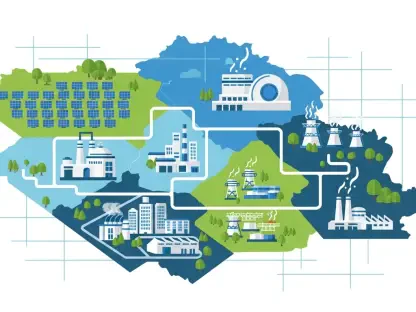Welcome to an insightful conversation with Christopher Hailstone, a seasoned expert in energy management and renewable energy, with a deep understanding of electricity delivery and grid reliability. As our trusted Utilities expert, Christopher brings a wealth of knowledge to the table, especially when it comes to navigating the complex interplay of geopolitics, market dynamics, and oil price fluctuations. Today, we’ll dive into the recent slide of oil prices to an eight-week low, exploring the roles of U.S.-Russia diplomatic talks, new tariffs on India, OPEC+ decisions, and unexpected shifts in U.S. crude inventories, all while unpacking how these factors shape the global energy landscape.
How do you see recent geopolitical developments influencing the drop in oil prices to an eight-week low?
Well, the recent slide in oil prices, with Brent crude dropping about 1.1% to $66.89 a barrel and West Texas Intermediate falling 1.2% to $64.35, is tied to a swirl of uncertainty sparked by U.S. President Donald Trump’s comments on talks with Russia. His remarks about making “great progress” in discussions with Moscow have raised questions about whether sanctions on Russia might ease up. Since Russia is the world’s second-largest crude producer, any hint of reduced sanctions could mean more oil flooding the market, which naturally pressures prices downward. It’s a classic case of geopolitical rhetoric creating market jitters.
Can you elaborate on the significance of the U.S.-Russia talks and what they might mean for global oil supply?
Absolutely. Trump sent his special envoy, Steve Witkoff, to meet with Vladimir Putin, and while details are scarce, the mention of “great progress” suggests there’s movement toward some kind of resolution, possibly tied to ending the conflict in Ukraine. If sanctions on Russia are scaled back, it could simplify their ability to export oil, increasing global supply at a time when markets are already skittish. This uncertainty is a big driver behind the current price weakness, as traders brace for potential shifts in supply dynamics.
What’s your take on the new tariffs imposed by the U.S. on India and their ripple effects on the oil market?
The U.S. decision to slap an additional 25% tariff on goods from India, effective 21 days after August 7, is a direct response to India’s role as a major buyer of Russian oil. Trump’s administration views this as indirectly supporting Russia’s economy amidst ongoing tensions. India, alongside China, has been a key market for Russian crude, especially post-sanctions. These tariffs could strain India’s economy and potentially reduce their appetite for Russian oil if costs rise too much, which might force Russia to redirect supply elsewhere or lower prices, further impacting global benchmarks.
How are OPEC+ strategies currently shaping oil price trends?
OPEC+ has been a significant factor lately, with their planned supply increase weighing on prices. When a group as influential as OPEC+ signals more oil coming to market, it often overshadows other supportive factors. On the flip side, Saudi Arabia’s decision to raise crude prices for Asian buyers in September, marking the second consecutive monthly hike, reflects tight supply and strong regional demand. It’s a mixed bag—OPEC+ is trying to balance market stability with their own production goals, but the net effect right now is downward pressure on prices due to the anticipated supply bump.
Could you walk us through the recent U.S. crude inventory data and why it offered some counterbalance to falling prices?
Sure, the U.S. Energy Information Administration reported a draw of 3 million barrels of crude from inventories for the week ending August 1. That’s a much larger drop than the 0.6 million barrels analysts had forecasted, though it’s a bit less than the 4.2 million barrels cited by the American Petroleum Institute. This significant drawdown suggests stronger-than-expected demand or reduced supply inflows, which provided a bit of a cushion to oil prices. Even amidst the broader decline driven by geopolitical noise, inventory drops like this signal underlying market tightness that can bolster prices temporarily.
What role do you think India’s diplomatic moves, particularly with China, might play in the oil market?
India’s Prime Minister Narendra Modi’s upcoming visit to China, the first in over seven years, is a noteworthy development. It signals a warming of ties between the two nations at a time when U.S.-India relations are getting testy over tariffs and Russian oil purchases. If India and China strengthen their economic and diplomatic bonds, it could reshape oil demand patterns in Asia, potentially increasing coordinated buying of discounted Russian crude. This might further complicate U.S. efforts to isolate Russia’s oil revenues and could keep downward pressure on prices if supply remains abundant.
Looking ahead, what’s your forecast for oil price stability given these overlapping uncertainties with sanctions, tariffs, and supply decisions?
I think we’re in for a bumpy ride over the next few months. The uncertainty around U.S.-Russia sanctions could swing either way—easing tensions might flood the market with Russian oil, pushing prices down, while stricter measures could tighten supply and drive prices up. Tariffs on India add another layer of complexity, potentially disrupting key demand centers. Meanwhile, OPEC+ supply increases are a wildcard depending on how much they ramp up production. My forecast is cautious: we could see oil prices hover in a tight range, with volatility spiking on any major geopolitical or policy announcements. Markets hate uncertainty, and right now, there’s plenty of it to go around.









